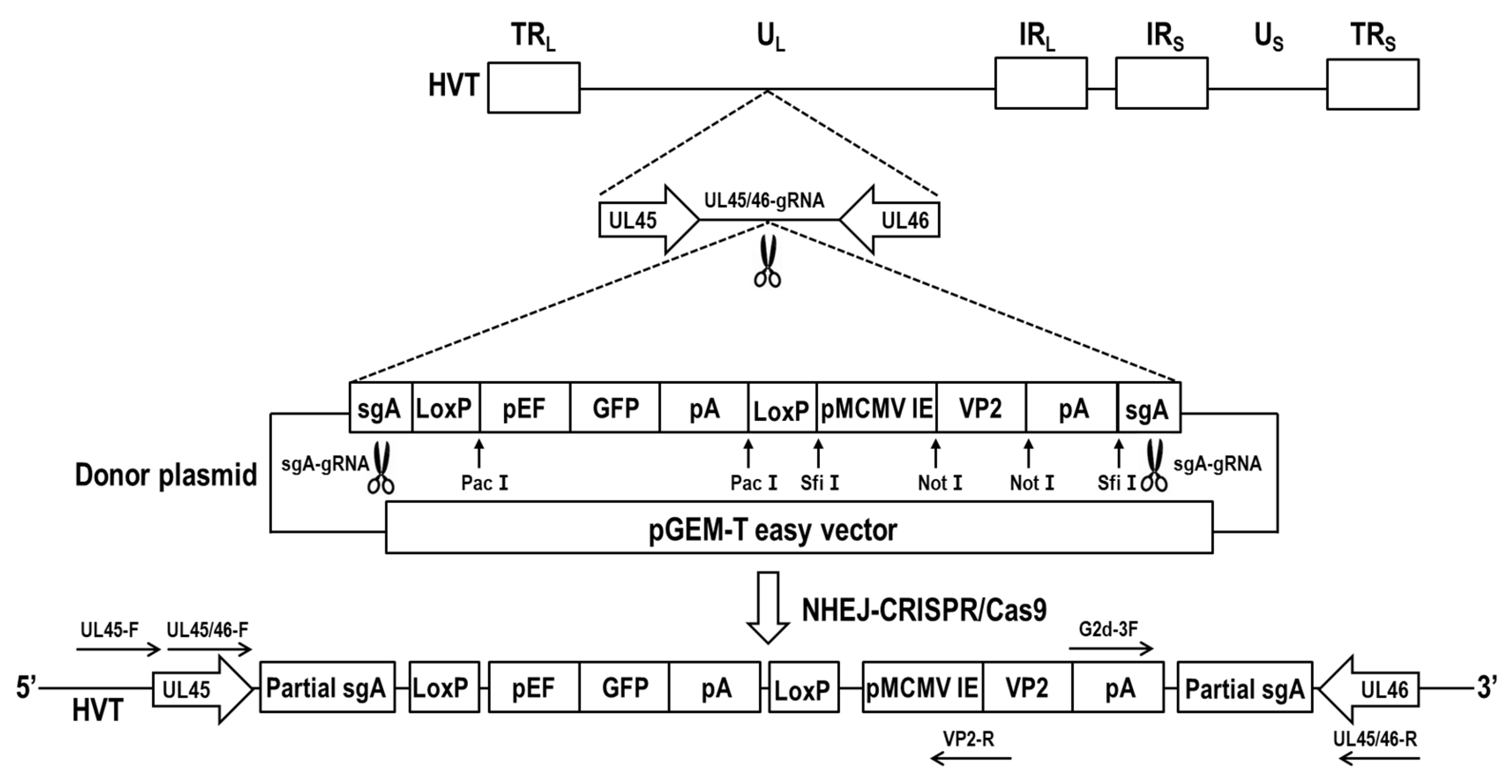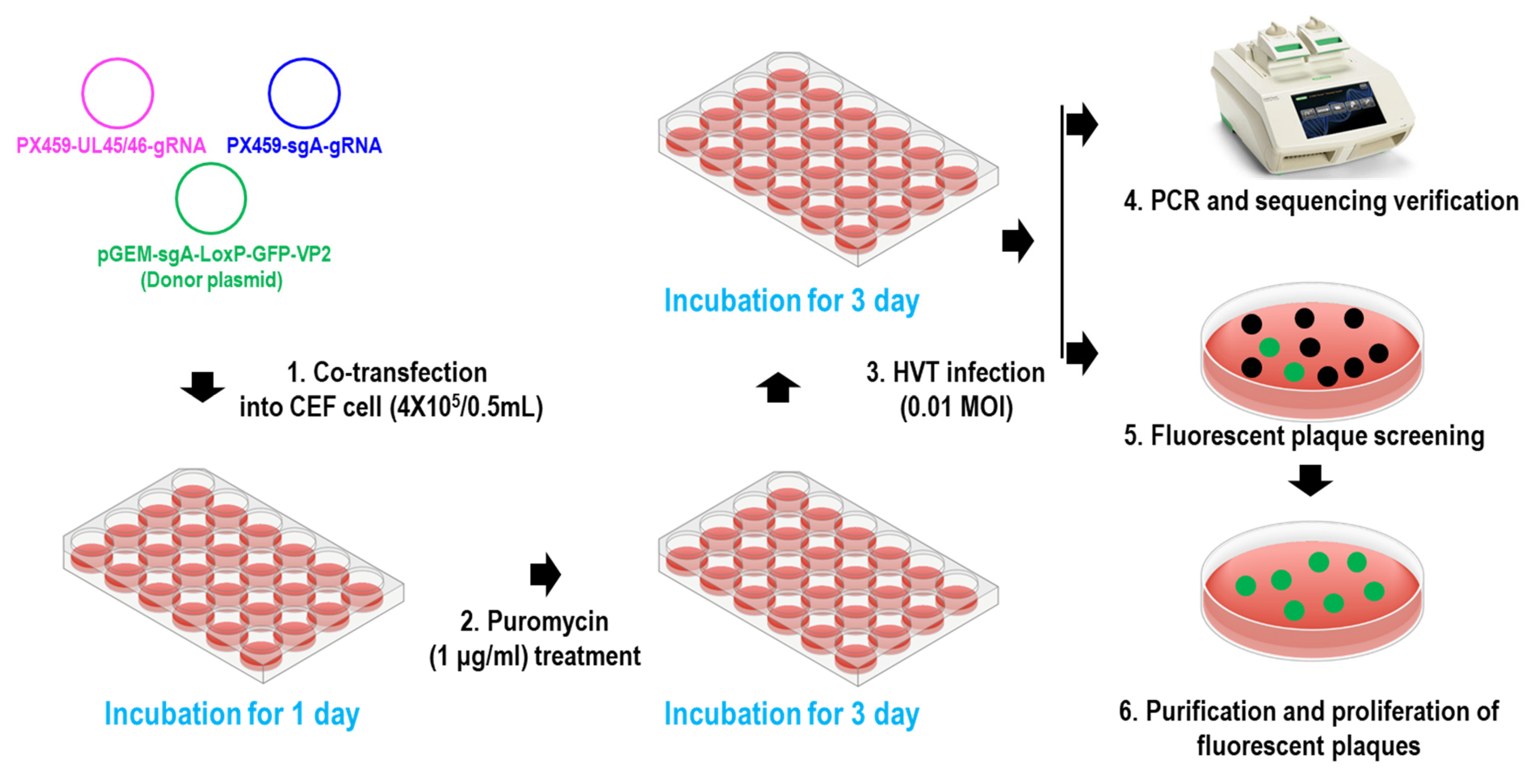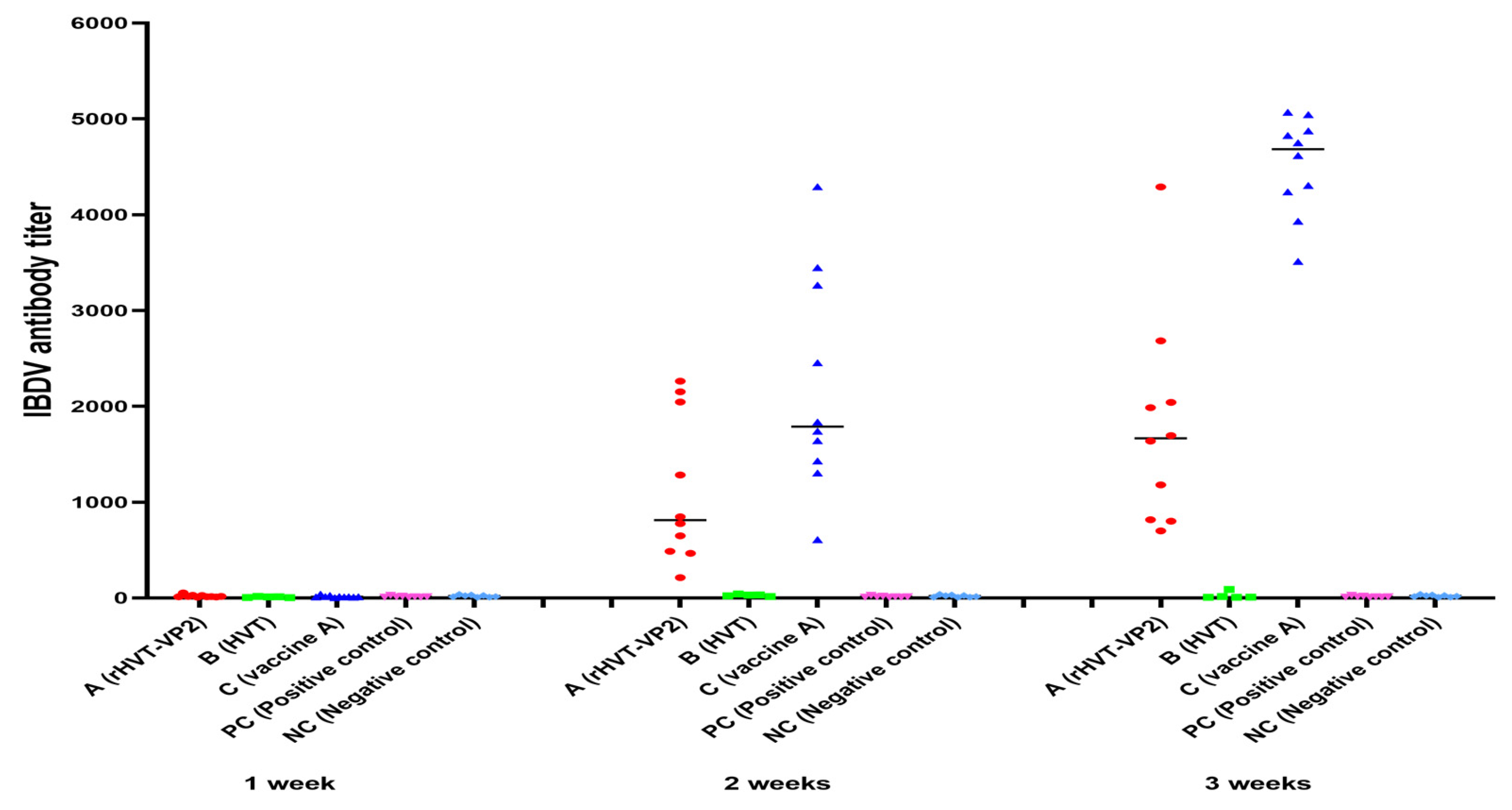Development of a Highly Efficient CRISPR/Cas9-Mediated Herpesvirus of Turkey-Based Vaccine against Novel Variant Infectious Bursal Disease Virus
Abstract
:1. Introduction
2. Materials and Methods
2.1. Viruses and Cell Culture
2.2. Construction of the Cas9/gRNA Expression Plasmid and Donor Plasmid
2.3. Generation of Recombinant rHVT-VP2
2.4. Stability
2.5. Vaccination and Challenge Experiment
2.6. Serology
2.7. Clinical Signs, Mortality, and Postmortem Lesions
2.8. Bursa-to-Body-Weight Index and Spleen Index
2.9. Statistical Analysis
3. Results
3.1. Identification of PX459-UL45/46-gRNA and PX459-SGA-gRNA
3.2. Generation of Recombinant rHVT-VP2
3.3. Purification of Recombinant rHVT-VP2
3.4. Stability
3.5. Humoral Immune Response
3.6. Clinical Signs, Mortality, Pathology, and Virus Detection
4. Discussion
5. Conclusions
Supplementary Materials
Author Contributions
Funding
Institutional Review Board Statement
Data Availability Statement
Conflicts of Interest
References
- Mahgoub, H.A.; Bailey, M.; Kaiser, P. An overview of infectious bursal disease. Arch. Virol. 2012, 157, 2047–2057. [Google Scholar] [CrossRef]
- Thai, T.N.; Jang, I.; Kim, H.A.; Kim, H.S.; Kwon, Y.K.; Kim, H.R. Characterization of antigenic variant infectious bursal disease virus strains identified in South Korea. Avian Pathol. 2021, 50, 174–181. [Google Scholar] [CrossRef]
- Tomas, G.; Marandino, A.; Techera, C.; Olivera, V.; Perbolianachis, P.; Fuques, E.; Grecco, S.; Hernandez, M.; Hernandez, D.; Calleros, L.; et al. Origin and global spreading of an ancestral lineage of the infectious bursal disease virus. Transbound. Emerg. Dis. 2020, 67, 1198–1212. [Google Scholar] [CrossRef] [PubMed]
- Thai, T.N.; Yoo, D.-S.; Jang, I.; Kwon, Y.-K.; Kim, H.-R. Dynamics of the Emerging Genogroup of Infectious Bursal Disease Virus Infection in Broiler Farms in South Korea: A Nationwide Study. Viruses 2022, 14, 1604. [Google Scholar] [CrossRef] [PubMed]
- Myint, O.; Suwanruengsri, M.; Araki, K.; Izzati, U.Z.; Pornthummawat, A.; Nueangphuet, P.; Fuke, N.; Hirai, T.; Jackwood, D.J.; Yamaguchi, R. Bursa atrophy at 28 days old caused by variant infectious bursal disease virus has a negative economic impact on broiler farms in Japan. Avian Pathol. 2021, 50, 6–17. [Google Scholar] [CrossRef] [PubMed]
- Aliyu, H.B.; Hair-Bejo, M.; Omar, A.R.; Ideris, A. Genetic Diversity of Recent Infectious Bursal Disease Viruses Isolated From Vaccinated Poultry Flocks in Malaysia. Front. Vet. Sci. 2021, 8, 643976. [Google Scholar] [CrossRef] [PubMed]
- Fan, L.; Wu, T.; Wang, Y.; Hussain, A.; Jiang, N.; Gao, L.; Li, K.; Gao, Y.; Liu, C.; Cui, H.; et al. Novel variants of infectious bursal disease virus can severely damage the bursa of fabricius of immunized chickens. Vet. Microbiol. 2020, 240, 108507. [Google Scholar] [CrossRef] [PubMed]
- Hein, R.; Koopman, R.; Garcia, M.; Armour, N.; Dunn, J.R.; Barbosa, T.; Martinez, A. Review of Poultry Recombinant Vector Vaccines. Avian Dis. 2021, 65, 438–452. [Google Scholar] [CrossRef] [PubMed]
- Kamel, M.; El-Sayed, A. Utilization of herpesviridae as recombinant viral vectors in vaccine development against animal pathogens. Virus Res. 2019, 270, 197648. [Google Scholar] [CrossRef] [PubMed]
- Li, Y.Q.; Reddy, K.; Reid, S.M.; Cox, W.J.; Brown, I.H.; Britton, P.; Nair, V.; Iqbal, M. Recombinant herpesvirus of turkeys as a vector-based vaccine against highly pathogenic H7N1 avian influenza and Marek’s disease. Vaccine 2011, 29, 8257–8266. [Google Scholar] [CrossRef] [PubMed]
- Tang, N.; Zhang, Y.Y.; Pedrera, M.; Chang, P.X.; Baigent, S.; Moffat, K.; Shen, Z.Q.; Nair, V.; Yao, Y.X. A simple and rapid approach to develop recombinant avian herpesvirus vectored vaccines using CRISPR/Cas9 system. Vaccine 2018, 36, 716–722. [Google Scholar] [CrossRef]
- Jiang, F.G.; Doudna, J.A. CRISPR-Cas9 Structures and Mechanisms. Annu. Rev. Biophys. 2017, 46, 505–529. [Google Scholar] [CrossRef]
- Vilela, J.; Rohaim, M.A.; Munir, M. Application of CRISPR/Cas9 in Understanding Avian Viruses and Developing Poultry Vaccines. Front. Cell. Infect. Microbiol. 2020, 10, 581504. [Google Scholar] [CrossRef] [PubMed]
- Tang, N.; Zhang, Y.; Pedrera, M.; Chang, P.; Baigent, S.; Moffat, K.; Shen, Z.; Nair, V.; Yao, Y. Generating Recombinant Avian Herpesvirus Vectors with CRISPR/Cas9 Gene Editing. J. Vis. Exp. 2019, 143, e58193. [Google Scholar] [CrossRef]
- Takase, K.; Baba, G.M.; Ariyoshi, R.; Fujikawa, H. Susceptibility of chicken embryos to highly virulent infectious bursal disease virus. J. Vet. Med. Sci. 1996, 58, 1129–1131. [Google Scholar] [CrossRef] [PubMed]
- Palya, V.; Tatar-Kis, T.; Mato, T.; Felfoldi, B.; Kovacs, E.; Gardin, Y. Onset and long-term duration of immunity provided by a single vaccination with a turkey herpesvirus vector ND vaccine in commercial layers. Vet. Immunol. Immunopathol. 2014, 158, 105–115. [Google Scholar] [CrossRef] [PubMed]
- Liu, L.; Wang, T.; Wang, M.; Tong, Q.; Sun, Y.; Pu, J.; Sun, H.; Liu, J. Recombinant turkey herpesvirus expressing H9 hemagglutinin providing protection against H9N2 avian influenza. Virology 2019, 529, 7–15. [Google Scholar] [CrossRef] [PubMed]
- Jackwood, D.J. Advances in vaccine research against economically important viral diseases of food animals: Infectious bursal disease virus. Vet. Microbiol. 2017, 206, 121–125. [Google Scholar] [CrossRef]
- Baigent, S.J.; Petherbridge, L.J.; Smith, L.P.; Zhao, Y.G.; Chesters, P.M.; Nair, V.K. Herpesvirus of turkey reconstituted from bacterial artificial chromosome clones induces protection against Marek’s disease. J. Gen. Virol. 2006, 87, 769–776. [Google Scholar] [CrossRef] [PubMed]
- Li, K.; Liu, Y.Z.; Liu, C.J.; Gao, L.; Zhang, Y.P.; Cui, H.Y.; Gao, Y.L.; Qi, X.L.; Zhong, L.; Wang, X.M. Recombinant Marek’s disease virus type 1 provides full protection against very virulent Marek’s and infectious bursal disease viruses in chickens. Sci. Rep. 2016, 6, 39263. [Google Scholar] [CrossRef]
- Tang, N.; Zhang, Y.; Sadigh, Y.; Moffat, K.; Shen, Z.; Nair, V.; Yao, Y. Generation of A Triple Insert Live Avian Herpesvirus Vectored Vaccine Using CRISPR/Cas9-Based Gene Editing. Vaccines 2020, 8, 97. [Google Scholar] [CrossRef]
- Chang, P.; Ameen, F.; Sealy, J.E.; Sadeyen, J.-R.; Bhat, S.; Li, Y.; Iqbal, M. Application of HDR-CRISPR/Cas9 and Erythrocyte Binding for Rapid Generation of Recombinant Turkey Herpesvirus-Vectored Avian Influenza Virus Vaccines. Vaccines 2019, 7, 192. [Google Scholar] [CrossRef]
- Wyman, C.; Kanaar, R. DNA double-strand break repair: All’s well that ends well. Annu. Rev. Genet. 2006, 40, 363–383. [Google Scholar] [CrossRef] [PubMed]
- He, X.J.; Tan, C.L.; Wang, F.; Wang, Y.F.; Zhou, R.; Cui, D.X.; You, W.X.; Zhao, H.; Ren, J.W.; Feng, B. Knock-in of large reporter genes in human cells via CRISPR/Cas9-induced homology-dependent and independent DNA repair. Nucleic Acids Res. 2016, 44, e85. [Google Scholar] [CrossRef] [PubMed]
- Mao, Z.Y.; Bozzella, M.; Seluanov, A.; Gorbunova, V. Comparison of nonhomologous end joining and homologous recombination in human cells. DNA Repair 2008, 7, 1765–1771. [Google Scholar] [CrossRef] [PubMed]
- Chang, P.; Yao, Y.; Tang, N.; Sadeyen, J.-R.; Sealy, J.; Clements, A.; Bhat, S.; Munir, M.; Bryant, J.E.; Iqbal, M. The Application of NHEJ-CRISPR/Cas9 and Cre-Lox System in the Generation of Bivalent Duck Enteritis Virus Vaccine against Avian Influenza Virus. Viruses 2018, 10, 81. [Google Scholar] [CrossRef]
- McCarty, N.S.; Graham, A.E.; Studena, L.; Ledesma-Amaro, R. Multiplexed CRISPR technologies for gene editing and transcriptional regulation. Nat. Commun. 2020, 11, 1281. [Google Scholar] [CrossRef] [PubMed]
- Guo, C.T.; Ma, X.T.; Gao, F.; Guo, Y.X. Off-target effects in CRISPR/Cas9 gene editing. Front. Bioeng. Biotechnol. 2023, 11, 1143157. [Google Scholar] [CrossRef] [PubMed]
- Sadigh, Y.; Powers, C.; Spiro, S.; Pedrera, M.; Broadbent, A.; Nair, V. Gallid herpesvirus 3 SB-1 strain as a recombinant viral vector for poultry vaccination. NPJ Vaccines 2018, 3, 21. [Google Scholar] [CrossRef] [PubMed]
- Afonso, C.L.; Tulman, E.R.; Lu, Z.; Zsak, L.; Rock, D.L.; Kutish, G.F. The genome of turkey herpesvirus. J. Virol. 2001, 75, 971–978. [Google Scholar] [CrossRef]




| Primer | Sequence (5′-3′) | Reference |
|---|---|---|
| UL45/46-gRNA-F | CACCGAAAACACAGTAACCGTTAG | [11] |
| UL45/46-gRNA-R | AAACCTAACGGTTACTGTGTTTTC | |
| sg-A-gRNA-F | CACCGAGATCGAGTGCCGCATCAC | |
| sg-A-gRNA-R | AAACGTGATGCGGCACTCGATCTC | |
| U6 forward | GACTATCATATGCTTACCGT | |
| UL45-F | TGTCGGCAGACTGTCCTGTA | |
| VP2-R | GTGCATGACCGTGCTGATTC | |
| G2d-3F | CGTCTTGGCATCAAGACCGT | |
| UL45/46-F | GATGCCCGCGTGTATCTTCA | |
| UL45/46-R | ACGTAGGCTGAAAGTGTCCAG |
| Group | 7 Days Post-Challenge | |||||||
|---|---|---|---|---|---|---|---|---|
| Mortality | Gross Lesion a | Bursa Lesion b | b/B Ratio c | BBIX d (Atrophy, %) | s/B Ratio e | Virus Detection in Bursa | PI f | |
| A (rHVT-VP2) | 0/10 (0%) | 0/10 (0%) | 0/10 (0%) | 4.99 ± 0.54 | 0.99 ± 0.11 (0/10, 0%) | 2.36 ± 0.61 | 0/10 (0%) | 100% |
| B (HVT) | 0/5 (0%) | 0/5 (0%) | 5/5 (100%) | 1.33 ± 0.23 | 0.27 ± 0.05 (5/5, 100%) | 3.12 ± 0.46 | 4/5 (80%) | 0% |
| C (vaccine A) | 0/10 (0%) | 0/10 (0%) | 6/10 (60%) | 3.20 ± 1.66 | 0.64 ± 0.33 (6/10, 60%) | 2.58 ± 0.55 | 4/10 (40%) | 40% |
| PC (Positive control) | 0/8 (0%) | 1/8 (12.5%) | 8/8 (100%) | 1.61 ± 0.29 | 0.32 ± 0.06 (8/8, 100%) | 3.29 ± 0.39 | 8/8 (100%) | - |
| NC (Negative control) | 0/8 (0%) | 0/8 (0%) | 0/8 (0%) | 5.02 ± 0.83 | - | 1.94 ± 0.36 | 0/8 (0%) | - |
Disclaimer/Publisher’s Note: The statements, opinions and data contained in all publications are solely those of the individual author(s) and contributor(s) and not of MDPI and/or the editor(s). MDPI and/or the editor(s) disclaim responsibility for any injury to people or property resulting from any ideas, methods, instructions or products referred to in the content. |
© 2024 by the authors. Licensee MDPI, Basel, Switzerland. This article is an open access article distributed under the terms and conditions of the Creative Commons Attribution (CC BY) license (https://creativecommons.org/licenses/by/4.0/).
Share and Cite
Zhang, J.-F.; Park, J.-Y.; Kim, S.-W.; Choi, Y.-R.; Cha, S.-Y.; Jang, H.-K.; Wei, B.; Kang, M. Development of a Highly Efficient CRISPR/Cas9-Mediated Herpesvirus of Turkey-Based Vaccine against Novel Variant Infectious Bursal Disease Virus. Vaccines 2024, 12, 226. https://doi.org/10.3390/vaccines12030226
Zhang J-F, Park J-Y, Kim S-W, Choi Y-R, Cha S-Y, Jang H-K, Wei B, Kang M. Development of a Highly Efficient CRISPR/Cas9-Mediated Herpesvirus of Turkey-Based Vaccine against Novel Variant Infectious Bursal Disease Virus. Vaccines. 2024; 12(3):226. https://doi.org/10.3390/vaccines12030226
Chicago/Turabian StyleZhang, Jun-Feng, Jong-Yeol Park, Sang-Won Kim, Yu-Ri Choi, Se-Yeoun Cha, Hyung-Kwan Jang, Bai Wei, and Min Kang. 2024. "Development of a Highly Efficient CRISPR/Cas9-Mediated Herpesvirus of Turkey-Based Vaccine against Novel Variant Infectious Bursal Disease Virus" Vaccines 12, no. 3: 226. https://doi.org/10.3390/vaccines12030226





